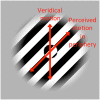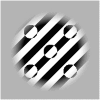The Role of Feature Tracking in the Furrow Illusion
- PMID: 27014018
- PMCID: PMC4779897
- DOI: 10.3389/fnhum.2016.00081
The Role of Feature Tracking in the Furrow Illusion
Abstract
In the furrow illusion (Anstis, 2012), the perceived path of a moving target follows the veridical path orientation when viewed foveally, but follows the orientation of the texture when viewed peripherally. These radically different motion percepts depending on whether the stimulus is viewed foveally or peripherally has led Anstis to conclude that the furrow illusion reveals "profound differences in the way that the periphery and fovea process visual motion." In the current study, we rather argue that the different percepts can be explained by reduced position acuity with eccentricity and therefore do not imply different ways of processing motion per se. If feature tracking, which is position-based, is involved in the perception of the veridical motion direction, then impairing the feature tracking motion system should strengthen the illusion. To reduce contribution of the feature tracking motion system, we used a crowding paradigm consisting in presenting many nearby targets. We found that under crowding conditions, the furrow illusion was stronger. We conclude that feature tracking was involved in the perception of the veridical motion direction, which is compatible with the hypothesis that the different motion percepts at fixation and in the periphery are due to a reduced position acuity with eccentricity affecting feature tracking, not to different ways of processing motion per se.
Keywords: attentional resolution; crowding; feature tracking; furrow illusion; motion; periphery.
Figures




References
-
- Adelson E. H., Bergen J. R. (1985). Spatiotemporal energy models for the perception of motion. J. Opt. Soc. Am. A Opt. Image Sci. Vis. 2, 284–229. - PubMed
LinkOut - more resources
Full Text Sources
Other Literature Sources

